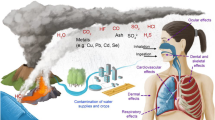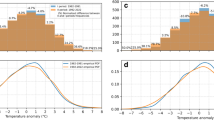Abstract
The long-term, 26 years’ data set of observations on daily concentrations of airborne grass pollen in Leiden is analyzed to present the variations and trends in quantities, and season starting dates. Monitoring of airborne pollen has been done continuously at one location, with a volumetric pollen trap. Annual totals of daily average grass-pollen concentrations are within a normal range of an urban site between 3690 and 9277, averagely 5510. The annual totals are irregularly fluctuating from year to year, and show no increasing or decreasing trend. Each year’s seasonal fluctuation is different, probably under the influence of changing weather conditions. The typical grass-pollen month is June. Using the Σ 75 criterium, the average starting date is on 16 May, whereas with the 1% threshold criterium the start of the grass-pollen season averagely is on 3 June. The mean air temperature in the preceding period is taken as the main factor for the timing of the season start. Analyzing the relationships of the two different criteria for the season starts with a number of temperature observation periods, the best relations were found between the mean air temperature in the period 11 April to 20 May and the Σ 75 criterium season start on 16 May (r=−0.78); and between the mean air temperature in May and the 1% threshold criterium season start on 3 June (r=−0.76). Forecasts of the season start which are significantly better than the average starting date are only possible with the mean air temperature up to a few days before the actual start. This limits the practical usefulness of the forecasting system.
Similar content being viewed by others
References
Bricchi E, Frenguelli G, Mincigrucci G, Fornaciari M, Ferranti F, Romano B. Time linkages between pollination onsets of different taxa over an 11-year period in Perugia, central Italy. Aerobiologia 1995;11:57–61.
Davies RR, Smith LP. Forecasting the start and severity of the hay fever season. Clin Allergy 1973;3:263–7.
Driessen MNBM, van Herpen RMA, Moelands RPM, Spieksma FThM. Prediction of the start of the grass pollen season for the western part of the Netherlands. Grana 1989;28:37–44.
Driessen MNBM, van Herpen RMA, Smithuis LOMJ. Prediction of the start of the grass pollen season for the southern part of the Netherlands. Grana 1990;29:79–86.
El-Ghazali G, El-Ghazali P-K, Larsson K-A, Nilsson S. Comparison of airborne pollen grains in Huddinge and Stockholm, Sweden. Aerobiologia 1993;9:53–67.
Emberlin J, Savage M, Jones S. Annual variations in grass pollen seasons in London 1961–1990: trends and forecast models. Clin Exp Allergy 1993a;23:911–8.
Emberlin J, Savage M, Woodman R. Annual variations in the concentrations ofBetula pollen in the London area, 1961–1990. Grana 1993b;32:359–63.
Frenguelli G, Bricchi E, Romano B, Mincigrucci G, Spieksma FThM. A predictive study on the beginning of the pollen season for Gramineae andOlea europaea L. Aerobiologia 1989;5:64–70.
Frenguelli G, Spieksma FThM, Bricchi E, Romano B, Mincigrucci G, Nikkels AH, Dankaart W, Ferranti F. The influence of air temperature on the starting dates of the pollen season ofAlnus andPopulus. Grana 1991;30:196–200.
Hirst JM. An automatic volumetric spore trap. Ann Appl Biol 1952;39:257–65.
Jäger S, Spieksma FThM, Nolard N. Fluctuations and trends in airborne concentrations of some abundant pollen types, monitored at Vienna, Leiden, and Brussels. Grana 1991;30:309–12.
Käpylä M, Penttinen A. An evaluation of the microscopical counting methods of the tape in Hirst-Burkard pollen and spore trap. Grana 1981;20:131–41.
KNMI, Maandelijks Overzicht van het Weer (MOW) in Nederland, uitgave 94a, 1969–1994:66–91.
Lejoly-Gabriel M. Recherches écologiques sur la pluie pollinique en Belgique. Acta Geogr Lovaniensa 1978;13:1–279.
Leuschner RM. Luftpollenbestimmung in Basel während der Jahre 1969 und 1970. Verh Naturforsch Ges Basel 1974;84:521–626.
Mullenders W. Aeropalynological research in Belgium. In: Charpin J, Surinyach R, Frankland AW (Eds.), Atlas of European Allergenic Pollens, Paris, Sandoz, 1974:95–102.
Mullenders W, Dirickx M, Van der Haegen D, Bastin-Servais Y, Désair-Coremans M. La pluie pollinique à Louvain—Heverlee, en 1971. Louvain Méd 1972;91:159–76.
Nikkels AH, Terstegge P, Spieksma FThM. Ten types of microscopically identifiable airborne fungal spores at Leiden, The Netherlands. Aerobiologia 1996;12:107–12.
Nilsson S, Persson S. Tree pollen spectra in the Stockholm region (Sweden), 1973–1980. Grana 1981;20:179–82.
Ogden EC, Raynor GS, Hayes JV, Lewis DM, Haines JH. Manual for Sampling Airborne Pollen. New York: Hafner, 1974:49–95.
Ong EK, Taylor PE, Knox RB. Forecasting the onset of the grass pollen season in Melbourne (Australia). Aerobiologia 1997;13:43–8.
Pathirane L. Graphical determination of the main pollen season. Pollen Spores 1975;17:609–10.
Spieksma FThM. Daily hay fever forecast in The Netherlands. Radio broadcasting of the expected influence of the weather or subjective complaints of hay fever sufferers. Allergy 1980;35:593–603.
Spieksma FThM, van den Assem A, Collette BJA. Airborne pollen concentration in Leiden, The Netherlands, 1977–1981. II Poaceae (grasses), variations and relation to hay fever. Grana 1985;24:99–108.
Spieksma FThM, D’Amato G, Mullins J, Nolard N, Wachter R, Weeke ER. City spore concentrations in the European Economic Community (EEC). VI Poaceae (grasses), 1982–1986. Aerobiologia 1989a;5:38–43.
Spieksma FThM, Frenguelli G, Nikkels AH, Mincigrucci G, Smithuis LOMJ, Bricchi E, Dankaart W, Romano B. Comparative study of airborne pollen concentrations in central Italy and The Netherlands (1982–1985), Emphasis on Alnus, Poaceae, and Artemisia. Grana 1989b;28:25–36.
Spieksma FThM, Emberlin JC, Hjelmroos M, Jäger S, Leuschner RM. Atmospheric birch (Betula) pollen in Europe: Trends and fluctuations in annual quantities and the starting dates of the seasons. Grana 1995;34:51–7.
Author information
Authors and Affiliations
Rights and permissions
About this article
Cite this article
Spieksma, F.M., Nikkels, A.H. Airborne grass pollen in Leiden, The Netherlands: annual variations and trends in quantities and season starts over 26 years. Aerobiologia 14, 347–358 (1998). https://doi.org/10.1007/BF02694304
Received:
Revised:
Accepted:
Issue Date:
DOI: https://doi.org/10.1007/BF02694304




